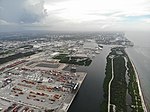Halmos College of Natural Sciences and Oceanography
AC with 0 elementsFlorida stubsNova Southeastern UniversityOceanographic organizationsOceanography stubs ... and 1 more
Universities and colleges in Broward County, Florida
The Halmos College of Natural Sciences and Oceanography is a natural science college at Nova Southeastern University in Florida. The college offers programs in subjects like biology and mathematics and conducts oceanographical research.
Excerpt from the Wikipedia article Halmos College of Natural Sciences and Oceanography (License: CC BY-SA 3.0, Authors).Halmos College of Natural Sciences and Oceanography
North Ocean Drive, Hollywood
Geographical coordinates (GPS) Address Phone number Website Nearby Places Show on map
Geographical coordinates (GPS)
| Latitude | Longitude |
|---|---|
| N 26.090694444444 ° | E -80.111111111111 ° |
Address
Nova Southeastern University Oceanographic Center
North Ocean Drive 8000
33004 Hollywood
Florida, United States
Open on Google Maps








